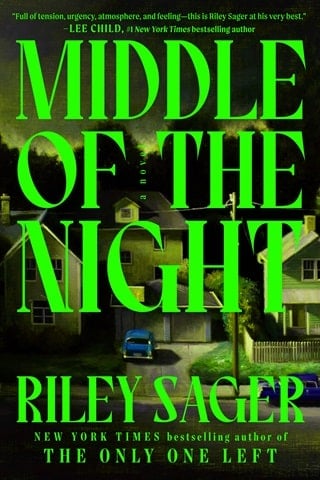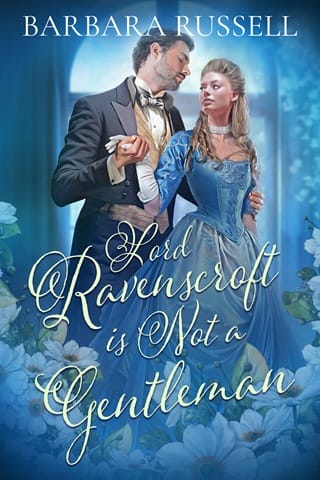Chapter Eighteen
On the outside, little about the mausoleum has changed in the past thirty years. It still rests in the shadows of the trees, the giant willows weeping onto the pitched roof. The only noticeable difference between then and now is the fat padlock on the gate, hanging from chains looped around the bars. Even though it's likely because of what happened thirty years ago, I can't help but have the same thought I did then: Is all this effort to prevent someone from entering—or the dead inside from escaping?
The other obvious change has nothing to do with the mausoleum, but with me. There's no way I'd fit between those bars now. I'd be lucky to get a leg through.
Yet there's something inside that I'm curious to see, so I venture off the path and approach the gate. Peering through the bars is an addition made since the last time I was here—a narrow box of granite placed directly on the mausoleum floor.
I aim my phone's flashlight into the darkness, sweeping it across the stone until I spot the name carved into it.
EZRA HAWTHORNE
While I'm not surprised that Mr. Hawthorne chose the institute grounds as his final resting place, I do find the plainness of it interesting. The man was rich as sin, and his family spent a fortune turning this piece of New Jersey woods into their own private estate. Yet he's buried inside a simple granite box that doesn't even include the years in which he was born and died. The only other writing I can see is an epitaph, etched a few inches beneath his name.
DEATH IS MERELY AN ILLUSION
I have no idea what that means. That Ezra Hawthorne believed in an afterlife? Or that there is no such thing and those who believe in it are fools? It makes me think about Billy. Dead—but also not. I wonder what Ezra would have thought about that.
I leave the mausoleum and move on, my steps quick against the gravel path. After I round another bend and pass a hedge maze that's seen better days, the mansion comes into view.
The structure sits large and stately against the rolling lawn. Wide and rambling, it bears no particular architectural style, making it seem like a building out of time. Something from a movie. Other than its size, the most striking feature about the Hawthorne mansion is its silence. The place is quiet. The only sounds I hear as I approach are my own footsteps, startlingly loud amid the overall hush. It makes me instinctively start to tiptoe, which might not even be necessary. I haven't seen or heard signs that anyone else is around.
Still, I try to make myself as inconspicuous as possible once I draw close to the mansion. Sneaking up to a window in the back, I cup my hands to the glass and look inside. It appears to be some kind of sitting room, with wingback chairs and a velvet sofa surrounding a low coffee table. A tapestry hangs from one wall, while another is filled with a large landscape painting.
The room itself looks to be empty—until a woman pops into view just on the other side of the glass. In a shaky voice, she says, "Whoever you are, please leave."
Startled, I leap away from the window, raising my hands like a burglar caught mid-theft. Not the look I want to go for. I drop them to my sides and say, "Hi! Sorry! I just wanted to take a look at your event facilities."
I have no idea how the lie arrived so quickly, but thank God it did, for the woman calms slightly. She points to her right, my left. I look that way and see a red door tucked into the rear of the building. I nod and make my way there, reaching the door thirty seconds before the woman opens it.
Standing in the doorway wearing a lavender pantsuit and a wary smile, she says, "I'm sorry, but we're closed."
"I just want to take a quick look around."
"Do you have an appointment?"
"No," I say. "I just saw this place online and felt like coming over to check it out for myself."
The woman takes in my sweaty, bedraggled appearance. "How did you get here? There are no other cars in the lot."
"My Uber dropped me off at the front gate."
Since the property is bordered by a stone wall, I'm fairly confident in my assumption that a gate sits at the front entrance. I'm less certain that said gate is currently open. Still, the woman offers another smile and says, "Well, we normally only give tours to those who schedule in advance. But since you're here, I suppose a quick look around won't hurt."
She ushers me inside to a plain, narrow corridor. Hurrying ahead of me, she gives me several over-the-shoulder glances. "I'm Lonette Jones," she says in the same way cops use the full names of kidnap victims in press conferences to try to humanize them in the eyes of their abductors.
"I'm Ethan," I reply, realizing a little too late that I probably shouldn't use my real name. "Ethan Smith."
"Is your event a wedding or a private party?"
"Wedding," I say, the lie popping out.
"Perhaps you can make an appointment and return with your fiancée."
"She's really busy right now." I cringe. Why do I keep talking? "But if I like what I see, I'll absolutely make an appointment and bring her along."
"Well, here we are," Lonette says when the corridor empties into an entrance hall that kind of resembles Downton Abbey. There's a similar faded grandeur to the place, which is stuffed to the rafters with mahogany, velvet, brocade. Evenly spaced portraits adorn the walls, hanging above side tables on which vases of flowers sit. Wooden beams crisscross the high ceiling, and sunlight streams in from tall windows.
The area is dominated by a staircase that sweeps upward to the second floor. Beneath it, a wide doorway leads to what looks to be a ballroom. I glimpse parquet floors, gilt trim, an unlit chandelier dangling like a massive cobweb.
Like the mansion's exterior, nothing inside the place seems overtly sinister. It's just a lot of finery purchased with old money. The only oddity comes in the form of a large oil painting near the front door. It depicts a young man in a dark suit, his gaze searing. Behind him is a gnarled tree on one side and a stone obelisk on the other.
"Ezra Hawthorne," Lonette says with a sigh when she catches me staring at it. "He lived here."
I move closer to the painting, noticing that both the tree and the obelisk bear strange markings. One is clearly a star. Another resembles a figure eight knocked on its side, which I know to be a sign for infinity. Most of the others, though, are foreign to me.
"What do those symbols mean?"
"Beats me. All I know is that brides hate it. But we're not allowed to take it down. Mr. Hawthorne stipulated it in his will." Returning to tour mode, Lonette drifts to the doorway of the ballroom. "This is a flexible space. It can be used for the ceremony or as a reception hall if the ceremony takes place outdoors."
I turn away from the painting and eye the stairs. "What's up there?"
"The second floor is off-limits to all guests, although we do allow wedding photos to be taken on the staircase."
While nothing in the area suggests that this used to be the Hawthorne Institute, let alone what they did here, I suspect remnants of that time still exist somewhere in this mansion. Maybe I'm wrong and there's nothing left to see. Or maybe it's all been relegated to the forbidden second floor. I decide to ply Lonette for more information.
"Didn't this place used to be a school at some point?"
"Yes, the Hawthorne Institute."
"What was their focus?"
Lonette seems taken aback, as if she's never been asked before. Maybe she hasn't. I assume that on most tours people are too busy checking out the amenities to care what the place was in the past.
"I don't really know. I've only been managing the event space for two years." Lonette lowers her voice to a whisper. "The rumor is that it was some kind of cult."
I try to appear unruffled, even as the word "occult" flashes through my thoughts like a neon bar sign.
"Do you think it's true?"
"No," Lonette says with a shrug. "But I can see why people would say that. Especially if they've been in the basement. It wasn't just the land and mansion that were donated to the county. All the furniture was, too. They just stuffed it all in the basement. It's creepy as heck, if you ask me."
I did ask her, and whether she intended to or not, Lonette has told me exactly where to look. Forget the second floor. I need to find my way into the basement. I even think I know how to get there: a closed door located directly beneath the main staircase.
While thinking of ways to get to it, I allow Lonette to lead me through the rest of the tour. In addition to the ballroom, I'm shown the preparation areas for the bride, groom, and other members of the wedding party; the kitchen facilities that caterers use; and the dining room where receptions can be held if the ceremony takes place in the ballroom.
The room I peered at through the window is where cocktail hours take place. Next to it is what Lonette refers to as "the recovery room," a small antechamber where guests who've drunk a bit too much can sober up. Soon we're back in the entrance hall, where Lonette hands me her card and recommends I return with my fiancée, after making an appointment.
"May I use your restroom?" I say, which is what I should have asked when she caught me at the window. It would have saved both of us some time.
Lonette points to a short hallway just past the door that I assume leads to the basement. "It's down the hall on the left."
I stroll toward the hallway, aware she's following my every move. Pretending to be confused, I pause at the door beneath the staircase.
"Further down," Lonette calls before I can open it. "And on your left."
I flash a sheepish grin and head toward the bathroom door, moving so slowly that Lonette gives up watching and retreats into her office. That's when I make my move. Hustling to the door beneath the staircase, I crack it open, slip inside, and quietly close it shut behind me.
I spend a moment in complete darkness, fumbling for a light switch. When I finally hit it, I see steps leading down to what's clearly a basement.
Jackpot.
At the bottom, I find myself in a massive stone-walled chamber that's been stuffed to the rafters with furniture, crates, and decades of detritus. It's all haphazardly arranged, with chairs on top of tables, shelves crammed full of curios, boxes stacked to teetering heights. Dust covers everything in thick layers. There are cobwebs, too, which fill the corners. All combined, it makes me feel like I've just entered the world's most haunted antiques store.
Stepping among the junk, I'm hit with a cold draft that makes the hair on the back of my neck stand at attention. Lonette is right: This place is creepy as heck.
Not helping is how half of the furniture is covered by drop cloths darkened with dust, looking unnervingly human-shaped. Not unlike the shadow people in Billy's book. I try to ignore them as I whip out my phone and start taking pictures, starting with the nearest shelf. I snap pictures of the grab bag of items placed there. A ceramic phrenology bust. A box inlaid with jewels. A wooden Ouija board.
Next, I open a nearby box, almost coughing as I get assailed by a cloud of dust. I quickly rifle through the books inside, spotting everything from leather-bound encyclopedias to an alleged book of spells. More books are in the next box I open, including an ancient-looking copy of Gray's Anatomy, Walden by Thoreau, a battered paperback of House of Horrors.
Since searching each box could take all day, I move to a pair of wooden trunks sitting side by side. Inside both are stacks of framed photographs. I quickly remove them and start taking pictures of each one, not stopping to notice what they depict. Most seem to be of long-ago events that took place in this very mansion. Groups of old white men in black suits staring at the camera. Gold plates at the bottom of the frames tell me the year they were taken, starting with 1937 and ending in 1998.
As I aim my phone at a photograph from 1993, one face stands out from the rest—a teenager posed beside a man who looks to be almost eighty years older. The older gentleman is clearly Ezra Hawthorne, and not just because he's dressed like the man in the portrait by the front door. I've seen enough photos of old Ezra to recognize him.
I also recognize the teenager next to him.
Johnny Chen.
Although I know he volunteered here, seeing him so obviously familiar with Ezra Hawthorne makes me gasp in shock—a sound loud enough to be heard through the closed door at the top of the stairs. From above, I hear Lonette say, "He's down there." It's followed by two sets of footfalls on the stairs.
I keep clicking, quickly capturing the photographs from the remaining years. I've just finished taking a picture of 1998 when Lonette enters the basement. With her is Ragesh Patel, and he's none too happy to see me.
"Hey, Ethan," he says with pronounced annoyance. "You're going to need to come with me."
 Fullepub
Fullepub 



